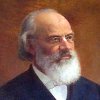Oliver Club
In this talk, I will explain the basic ideas of the algebraic theory of Dirac operators and present some of the applications and examples.
The Dirac operators have their origin in Dirac's famous idea that "taking the square root" of the wave operator (a second order differential operator in the space-time coordinates) involves coefficients given by certain $4\times 4$ matrices. In algebraic terms, this is equivalent to thinking of the Dirac operator as a differential operator with coefficients in the Clifford algebra. This idea found very fruitful generalizations in differential geometry and in the representation theory of Lie groups. One of the fundamental contributions to abstract harmonic analysis and Lie groups representations is Harish-Chandra's Plancherel decomposition of the space $L^2(G)$ for a semisimple Lie group $G$. The first geometric of the "atoms" of $L^2(G)$ was realized by Parthasarathy and Atiyah and Schmid using the kernel and index of the Dirac operator acting on sections of certain spinor bundles over Riemannian symmetric spaces.
Motivated by the analogy with semisimple Lie groups, several years ago, in joint works with D. Barbasch, P. Trapa, and E. Opdam, we proposed and studied an algebraic analogue of the Dirac operator for certain unital convolution algebras (affine Hecke algebras) that appear naturally in the representation theory of semisimple $p$-adic groups. This construction turned out to be generalizable to other similar types of algebras of interest, for example the rational Cherednik algebras (joint work with M. De Martino) which are deformations of the algebra of differential operators on a Euclidean space. There are also interesting connections and applications to parts of geometric representation theory, in particular, Springer's theory for finite reflection groups, the geometry of the nilpotent cone of a semisimple Lie algebra, and the geometry of the Calogero-Moser spaces for rational Cherednik algebras.
